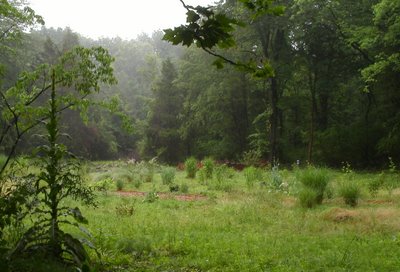Beneath the sea surface

The house is built on an earthen mound, so I see the garden from a height of about 15 feet. At dusk, and in fog, when partially obscured, the garden appears to be under water, perhaps recalling a sea floor of exotic plants and stationary creatures like sea anemones (miscanthus shapes, panicums), odd, almost monstrous forms of Rudbeckia maxima (flower spires emerging from some fantasy castle, or misshapen sea creatures in glaucous greens), sharp water irises. This is an intriguing metaphor to make the best of a difficult situation.
What grows, and survives the deer, suggests a grass and willow garden might be the answer. Many Miscanthus gracillimus - because they grow extremely well in these wet conditions and their manicured, weeping shapes contrast well with the dark woodland background, setting the open space apart, Miscanthus 'Silberfeder' for a bit more wildness and informality, probably Miscanthus Adagio and Yaku Jima for variety of size and complementary form. Small willows, not large trees ... to vary shape, texture, and color - Salix sachalinensis 'Sekka', Salix purpurea, Salix elaeagnos. But more than just miscanthus and salix, also other suitable survivors like the Rudbeckia maxima, Asclepias incarnata, Magnolia grandifolia, Magnolia virginiana. And I will continue to try other perennials whose deer survival story hasn't yet been told ... Eupatorium purpureum (and its cousins), Verbena hastata, Petasites japonicus. Other grasses, too - Panicum 'Dallas Blues', Shenandoah, Heavy Metal, Cloud Nine. Near the back, a mixed planting of Miscanthus 'Silberfeder' as background to petasites and Pycnanthemum muticum (stolen wholesale from Oehme and Van Sweden via Michael King's new book, Perennial Garden Design) - will it work where I want to try it?
Time will tell.
James Golden